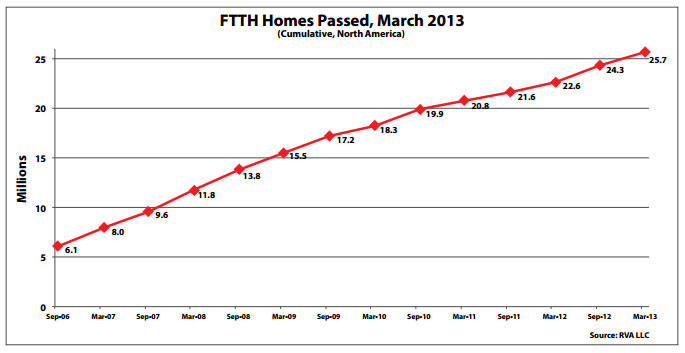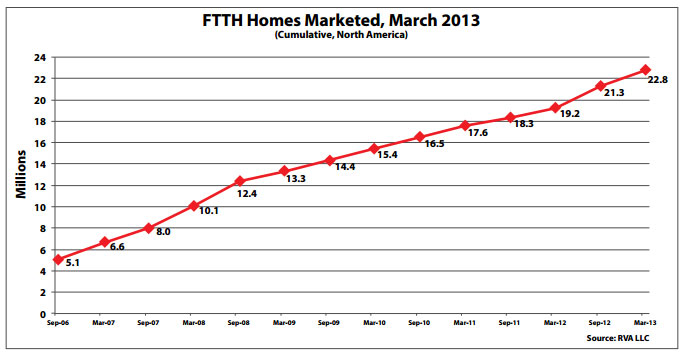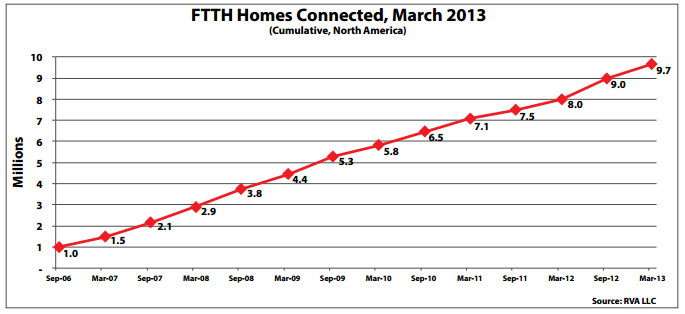With almost 1.4 million homes newly passed by fiber in the six months ending March 2013, the pace of fiber-to-the-home deployment in North America is exceeding long-term trends, even though it could not match the torrid pace of the prior six-month period.
The data comes from market researcher Michael Render of RVA LLC, who released his latest census of deployments as May drew to a close. His data gathering is funded in part by the Fiber to the Home Council Americas.
The slowdown from the prior six months, long predicted by Render, is due almost entirely to the windup of the U.S. stimulus program, which poured almost $7 billion into broadband projects starting in 2009. Fiber projects, both FTTH and middle-mile, dominated stimulus spending. Although the stimulus spending was dwarfed by Verizon and AT&T capital investment involving fiber in the same period, the needs of diverse stimulus-funded deployers (more than 400 local exchange carriers and municipalities) helped keep the industry’s North American vendors afloat.
New stimulus-funded middle-mile fiber infrastructure, by reducing interconnection costs, also improved business cases for small deployers seeking to give their communities and themselves a business edge. As U.S. deployments have slowed, other North American network builders, most notably in Canada and Mexico, have picked up much of the slack.
CONTINUED GROWTH
The number of homes passed by fiber in North America – that is, homes that can readily be connected to fiber – increased by 1.4 million to reach 25.7 million in March, Render says. The number of FTTH homes actually being marketed to customers rose 1.5 million to 22.8 million. That’s an increase of about 120,000 more than the increase in homes passed, reflecting the fact that deployers are working off the backlog their summer 2012 construction boom caused.
The result was healthy growth in the number of North American FTTH customers, which rose by 690,000 to a total of 9.7 million. The increase in the number of FTTH connections was below that of the March–September 2012 period but higher than in any other six-monthperiod since September 2009.
However, some of that growth was from outside the United States. The U.S., with about 8.8 million homes connected, has 91 percent of the connected homes in North America, down slightly from 92 percent at this time last year. Elsewhere in North America, fiber deployment has increased faster than in the U.S. Nevertheless, U.S. deployers have been more successful than those in other North American countries at turning homes passed into paying customers. The FTTH take rate for the U.S. is now 44.8 percent. For all of North America, it is 42.5 percent.

The rise in FTTH customers is well above the long-term trend. In part, this is because new builds have tended to be in rural areas and in multiple-dwelling unit (MDU) buildings. These types of deployments have had historically better take rates than competitive overbuilds in areas with mainly single family homes.
VIDEO IS A BRIGHT SPOT
More than 6.2 million customers now receive video over FTTH in North America – about two-thirds of all FTTH customers, even though FTTH deployers do not offer video services everywhere. Video is a particularly bright spot in the latest customer figures – up 372,000 in the six months ending March 2013. That’s close to the 399,000 increase recorded in the previous six months and more than in any other period since September 2010.


The number of homes connected rose by 690,000 in the six months ending last March.

months as 372,000 new households subscribed to FTTH video services in the six months ending last March.
In terms of jobs saved directly and the economic benefits of the infrastructure created, the FTTH segment of the stimulus program – less than 1 percent of all stimulus spending in the United States – must be ranked among the most successful of all the federally funded initiatives. Judging by the number and quality of project applications that poured in, three or four times as much money could have been efficiently spent on broadband.
Not bad for a program decried (on the basis of essentially no information whatsoever) on the front page of the New York Times as a “cyberbridge to nowhere” as the stimulus bill was being considered.
The Times is unlikely to ever correct its sloppy reporting. But will the ever increasing take rates and the improving economy entice Wall Street to fund more FTTH projects?